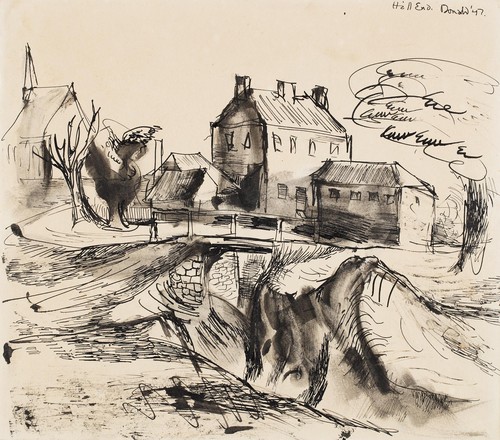Artist
and author Donald Friend (1915-1989) was born in Sydney. A student of Antonio
Dattilo-Rubbo, in the mid-1930s he travelled to England where he furthered his
studies. On his return to Sydney in 1940, Friend exhibited with the Society of
Artists and at the Macquarie Galleries before enlisting in the Australian
Imperial Force, on 29 June 1942, where he was first stationed at Albury, NSW,
where he cemented an important friendship with Russell Drysdale, painting with
him in his studio. In March 1945, Friend was commissioned as a lieutenant and
appointed a war artist; from May to September he served on Morotai and in
Borneo, before relinquishing his official commission in March 1946.
Back in Sydney Friend moved into
Merioola, a boarding house and Bohemian enclave at Woollahra – it was probably
the most exciting place for a young artist to live at the time but Friend soon tired
of the hedonism and distraction of urban life. In August 1947, he was planning
to move to Tasmania when he read an article in the Sydney Morning Herald about the old gold mining towns of western
NSW
Within
a couple of days Friend had persuaded Drysdale to ‘run in’ his recently
acquired Riley tourer and explore the landscape behind Bathurst. This two-day
excursion was to produce works which would provide the Australian public with a
searing reappraisal of previous held perceptions of our national landscape.
First
stop was ‘the lovely crazy old village’ of Sofala were both artists were soon
sketching the main street – later that year Drysdale’s ’Sofala’ main street was
entered in the Wynn Prize for landscape painting and won – a turning point in
the cultural consciousness of the nation.
Earlier
NSW artists groups, limited by the extent of railway access, had not ventured
past the Hawkesbury-Nepean catchment or the foreshores of Sydney harbour. On
returning to Sydney, Friend resolved to buy a cottage in the district,
convincing his companion Donald Murray to join him.
In
early September, Friend and Murray explored Hill End in search of a cottage
with enough land for a garden. They finally purchased a small, four-roomed wattle
and daub house on Clarke Street for $140.00 (£70.00). Previously owned by Louis
Beyers (co-owner the Holtermann nugget), it was ideally situated on an acre of
land and only a short walk to the General store and the Royal Hotel.
Over
the next few months the men began to restore the cottage while Murray, a keen
horticulturalist, designed a garden layout following the schemes of historical
gardens in the town – ornamental plantings either side of a path to the front
door with a vegetable patch and orchard in the rear. The interior of the
cottage was decorated with souvenirs from Friend’s travels including African
masks, a few pieces of colonial furniture, an extensive library of books and a
gramophone for music.
For
the next ten years, Friend’s life at Hill End was underpinned by routine –
working in his studio from 6am in the morning and often into the afternoon. The
evenings were the time for relaxation and entertainment. Friend produced many
images of Hill End during this time including this view – looking up on towards
Beyers’ cottage, next door to the two-storeyed Australian Joint Stock Bank on
the left, and opposite St Paul’s Presbyterian Church.
Fellow artists
from Sydney were curious to see for themselves the landscape that absorbed and
inspired both Friend's and Drysdale's creative energies. Soon, like-minded
artists such as Margaret Olley, Jean Bellette, David Strachan, Fred Jessup and
Jeffery Smart were attracted to visit, work and live in the town, forming the
nucleus of the artist community known as the Hill End group.
Ever
restless, from 1949 Friend moved between Italy, Greece and England. In 1951 he
was awarded the Flotta Lauro travelling art prize. On his return from Italy in
1953, Friend painted at Hill End, in North Queensland and at Drysdale’s Sydney
studio, before once more heading overseas.
By 1957, the
Hill End group started to break up. Russell Drysdale left for London in 1958 to
prepare work for a major exhibition. Donald Friend sailed for Ceylon (Sri Lanka),
staying there until 1961, while Donald Murray continued to live in the cottage.
In 1959 Friend gave his share in the Hill End
property to the Drysdales in settlement of a debt – they, in turn, gave it to
Murray who continued to live at the cottage (now known as Murray’s cottage)
until his death in 1988.
From
1957 to 1962, Friend lived in Ceylon (Sri Lanka) and, between 1967 and 1979, in
Bali, Indonesia, before returning to Australia, where he lived until his death
on 17 August 1989.
In
2003, Beyers’ cottage (now known as Murray’s cottage) became part of the Hill
End Artists in Residence Program, which aims to ensure that generations of
artists have the opportunity to experience artistic engagement in a community
set within its historic landscape.
Had Friend and Drysdale not discovered Hill End –
had they chosen to head south rather than west – post-war Australian art may
have been quite different. It is now seen as almost a rite of passage in NSW for artists
to live and work in the unique environment of Hill End which, in turn,
contributes to the long term cultural development and sustainability of the
Village.



 Back to list
Back to list